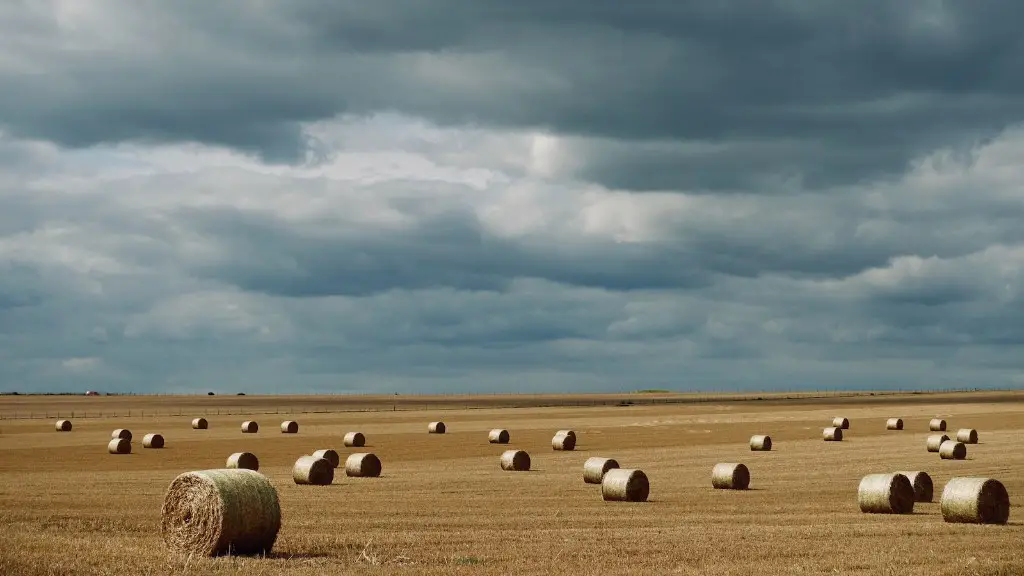Global warming in agriculture is a complex and pervasive problem that may have severe repercussions for humanity. It is a form of climate change that is directly caused by activities of humans, primarily the burning of fossil fuels. The rise in temperatures as a result of this leads to an array of problems in agriculture, ranging from changes to crop cycle lengths, flooding, fire and pestilence. This essay will explore these issues and the ways in which they impact both livelihoods and ecosystems.
The agricultural implications of climate change include a decrease in the productivity of crops due to the alteration of temperatures, leading to a decrease in overall yield. It is also directly responsible for an increase in the number of pests and diseases. The indirect effects however are just as significant, most notably the inundation of land with melting ice and snow and the increase in overall temperatures. This is likely to result in a change in the cycle lengths of crops and an increase in extreme weather events, resulting in further disaster for farmlands and loss of produce for farmers.
The effects of global warming on agricultural practices are too numerous to count, yet they are all deeply interconnected. Higher temperatures, caused by the warming atmosphere, can influence the water availability available to plants, the diffusion rate of nutrients, weed emergence and the emergence of crop diseases and pests. This can lead to additional problems such as desertification and drought, which in turn will cause food shortages. Although there is much uncertainty in the exact manifestation of these issues, it is clear that collectively, they will have a dire impact on agricultural production and even possibly human wellbeing.
It is essential to recognize that global warming in agriculture will require a collective effort from humanity to tackle the issue and ensure we can feed the billions of people who depend on our planet for sustenance. Solutions such as transitions to renewable energy sources, the implementation of effective agricultural practices such as agroforestry and technological advancement should all be explored and implemented if we are to make headway against the challenge.
The challenge is immense and the solutions are yet unknown. Humans should however not be daunted by this, as where there is a will there is a way. It is our duty to work together to ensure that this issue does not spiral out of control and leave us with only suffering to solve.
Types of Environmental Damage
Global warming has the potential to cause a damage to many different areas of the environment. Areas of arable land and grazing can be damaged in a number of different ways. Firstly, the increased heat can cause an unnatural increase in the rate of transpiration of the plants, causing them to draw on moisture quicker than they can obtain it, leading to a rapid dehydration of the land. Heat stress can also lead to a decrease in the number of available water bodies, caused by weather changes and drought, leading to a decrease in available water for the plants.
Another issue of global warming in agriculture is erosion. The rising temperatures causes an increase in wind speeds and rainfall, leading to increased erosion of topsoil. This can be further worsened by the overuse of agricultural land, leading to the destruction of the soil structure, ultimately leading to a decrease in overall productivity and quality of the land. This issue could be addressed through a change in farming approach, making use of no till farming practices and controlled composting in order to improve the fertility of the land.
Lastly, global warming can have a persistently high cost on the environment in the form of pests and diseases. This is caused by a shift in the climate that leads to increased numbers of disease-carrying insects, weeds, rodents and other pests. The impacts can be long-term, long beyond the period of the immediate warming trend. This can cause long-term damage to areas of agricultural land and ecosystems, leading to a decrease in the biodiversity and long-term irreversible damage.
Effects of Global Warming on Animal Life
Global warming has the potential to have a devastating effect on the planet’s ecosystems and the animals that inhabit them. Changes to the temperature and the climate can cause a shift in the habitats of these creatures, leading to a decrease in the available food sources and an overall reduction in their health, ultimately leading to a reduction in the populations of many species.
Initiating the process to reverse global warming in the animal kingdom may therefore depend on the changing of our current approach to the environment. The implementation of better energy policies should be a consideration, as should the introduction of better land management systems and practices. These should be actively encouraged by governments and businesses, as the effects of global warming in agriculture need to be managed if we are to ensure that the animals who inhabit this planet can survive.
It is worth considering the impact that global warming is having on biodiversity, as the effects of global warming are felt in a multitude of areas far wider than just changes in the land. Growing temperatures may lead to a decrease in the number of viable habitats for certain species, leading to a decrease in population numbers and the potential for extinctions. This has the potential to create an imbalance in the entire environment, leading to a destabilization of the ecosystems upon which we rely.
The effects of global warming on animal life is relentless, and it is up to us as humans to take responsibility and mitigate the effects. We should consider measures that are both short and long term, understanding the consequences of not just global warming but of climate change in general. We owe this to the creatures that inhabit this planet, as they have no control over their own lives and have to bear the consequences of our actions.
Food Insecurity and Global Warming
The effects of global warming in agriculture may lead to an increase in the number of people suffering from food insecurity. This is caused largely by the destruction of crops due to changes in the climate, but can also be related to socio-economic factors such as the price rise of food and the destruction of urban areas. These factors can be further worsened by the overuse and degradation of land, which causes a decrease in the overall fertility of the land, leading to decreased crop yields.
In order to overcome this growing issue, it is essential to recognize the underlying cause of the problem. Climate change and the destruction of natural resources are issues that are inextricably linked and must be tackled in tandem. The challenge of course, lies in the realization of these objectives and the understanding of the long-term implications of our actions.
We should also be cognizant of the wider implications of food insecurity, in terms of the impact on nutrition, health and wellbeing. Global warming in agriculture can lead to widespread famine, malnutrition and disease in areas that are already suffering from poverty, leading to further suffering and inequality. We should therefore be aware of this and take steps to mitigate the effects where possible.
It is of course impossible to fully predict the implications of global warming in agriculture, but it is important to at least consider the potential consequences. Global warming will likely cause a disturbance to the global food market, leading to price increases and a decrease in the level of food available to everyone. In order to combat this issue, we must attempt to tackle global warming and climate change in general, before it is too late.
Sustainable Practices for Mitigating Global Warming
Global warming has the potential to cause an immense amount of destruction, and it is up to us as humans to mitigate the effects. To do so, we must change both our attitudes and the practices that we have when it comes to the environment and the treatment of it. It is essential to understand the implications of not doing enough, and the irreversible damage that might occur.
In order to mitigate global warming in agriculture, it is necessary to explore both long and short-term solutions. Sustainable farming practices, such as no-till farming and controlled composting, have the potential to increase the fertility of the land, allowing it to better cope with the stresses of climate change. In addition, the use of renewable energy sources should be encouraged, with the introduction of renewable energy initiatives in the form of subsidies.
It is also important to look into the issue of water conservation. As mentioned before, global warming has the potential to cause a decrease in the availability of water, leading to destruction of crops. The implementation of better water harvesting systems may be required, as well as strategies for the utilization of water resources in a more effective manner. Again, depending on the area, different solutions may need to be considered and implemented.
The most important thing to combat global warming in agriculture however, is for governments and businesses to work together. Existing regulations should be enforced, new ones created and the public should be better informed on the implications of climate change. This should be done through the use of public relations campaigns and the implementation of corporate practices. Only then, can we properly take ownership of the problem and make a genuine effort to tackle it.
Global Warming and Global Opportunities
The challenge of global warming in agriculture is immense, yet it does provide a unique opportunity for humanity to truly understand the complexity of our relationship with the planet and to work out better solutions for the future. It is here that we can tap into new technologies, as well as develop effective policy solutions that are able to respond to the changing environment.
Developments at the global level require collaboration between governments, businesses and the public, with the aim to coordinate an international effort to tackle the challenge. Agreements should be made to reduce emissions and the reliance on fossil fuels, while the use of renewable energy sources should be increased. In addition, the setting of regulations with regards to land use and water management should be encouraged, as well as the promotion of better agricultural practices.
It is important to recognize that global change does also provide some opportunities. Namely, the demand for technological solutions, as well as for better educated, trained and equipped citizens. These are the people that, with the right incentives and information, will be able to tackle the challenge ahead. It is there, with the democratic empowerment of the masses, that we can make real progress on the issue.
Global warming could also lead to an increase in research and innovation, as well as increased investment in the development of sustainable solutions. This could mean investments in bio-fuels, hydroponics and other progressive solutions to global warming, increasing the chance of a viable, sustainable solution in the long run.
We should therefore not be dismayed at the challenge of global warming in agriculture, but instead look at it as an opportunity. It may be complex, but it is one that provides a unique chance for humans to feel the full brunt of the impact of climate change and to truly work together to create real solutions that we can all be proud of.





